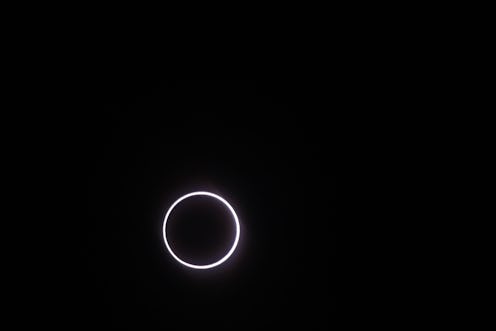Life
This Map Will Tell You Where To See 2017's Eclipse

If there's anything astronomers love more than space itself, it's predicting future events down to the tiniest calculation. The next solar eclipse isn't set to take place until August, but that hasn't stopped NASA from releasing a more accurate map of the solar eclipse earlier this week. Thanks to new data about the Moon's surface and Earth's own topography, the map gives us a better idea about the exact path the moon's shadow will take as it crosses the face of the planet. By extension, this means you can figure out your plans to watch the eclipse from the best spot.
According to NASA, this path is also known as the path of totality — the area where you can see the Moon pass in front of the Sun. Scientists have been calculating eclipse maps tracing the path of totality for quite some time, beginning with the 19th century mathematicians Friedrich Wilhelm Bessel and William Chauvene. However, these calculations are based on two greatly simplified assumptions: that observers are all at sea level, and that the Moon is a totally smooth sphere with a center of mass that's, well, centered.
Needless to say, that's not how nature works, so the resulting maps aren't as accurate as they could be. But these days, more detailed data about the Moon is available, and it's allowed NASA to create an eclipse map of unprecedented accuracy.
To compensate for the simplifications, mathematicians usually factor in elevation tables and the lunar limb, aka the edge of the Moon that's visible from Earth. Until this week, though, they've had to rely on limb profiles published all the way back in 1963, so the data is a little outdated.
That's where NASA's Lunar Reconnaissance Orbiter (LRO) comes in. Launched in 2009, the spacecraft orbits the Moon collecting detailed data about the Moon's surface. According to Science Daily, a NASA visualizer working at the Goddard Space Flight Center in Maryland used data from the LRO to create a more nuanced lunar limb profile. He also included NASA elevation maps to account for observers' altitudes — someone in the Colorado mountains, for example, is going to watch an eclipse from a very different angle than someone in Death Valley.
Just like Earth, the Moon has mountains and valleys that affect its movements throughout space, and NASA announced that these surface features influence the "timing and duration of totality by several seconds." It might not seem like much, but this is the first time scientists have created a time-varying eclipse map. Furthermore, the new visualizations show that rather than being a smooth ellipse, the moon's shadow is actually pretty irregular.
"We’ve known for a while now about the effects of the lunar limb and the elevation of observers on the Earth, but this is the first time we’ve really seen it in this way,” said visualizer Ernie Wright, according to NASA's announcement. “I think it’ll change how people think about mapping eclipses.”
The solar eclipse in question will take place on Aug. 21, 2017. Total eclipses are cool enough on their own, but this one is particularly special because it will span the continental United States from Oregon to South Carolina, passing over both the Rockies and the Appalachians. According to NASA, the last time a total eclipse crossed the United States was in 1918.
To learn more about the upcoming solar eclipse, you can find information on NASA's website. To check out the new map, head over here. It's still several months away, so don't forget to keep an eye out for the eclipse when the time comes — although something tells me it'll be hard to miss.